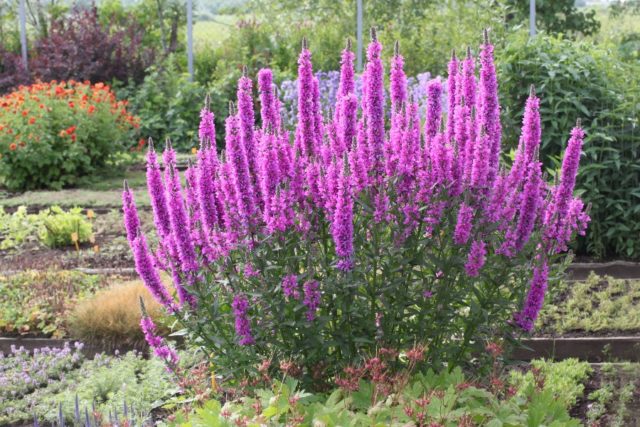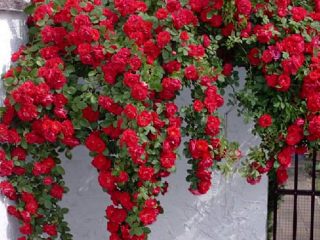Content
Merlin is one of the most unpretentious ornamental plants that only needs regular watering, rare fertilizing and pruning. The low (up to 100 cm) bush decorates the garden thanks to its lush spike-shaped inflorescences that appear continuously throughout the summer. This plant looks impressive in single and composition plantings.
Description of the twig-like merlin
Lythrum virgatum is a herbaceous perennial from the genus Derbennik, family Derbennikov. It is sometimes called vine or twig-like. This emphasizes the characteristic appearance of the shoots. They look like twigs, since the leaves and inflorescences are quite narrow, the shape of the stem is tetrahedral, and its height reaches 70-100 cm.
The leaves of the twig-shaped loosestrife are sessile (without a petiole), arranged oppositely (in pairs, opposite each other), rich green in color.The shape is lanceolate, they are very narrow in width, tapering towards the base. In inflorescences, the leaves are even smaller; they turn into bracts.
The inflorescence is spike-shaped, formed in the upper half of the stem. The flowers are no more than 1.5 cm in diameter, pale lilac in color. Flowering is long and continuous - from late June to mid-August (often until early September). The seeds ripen in small boxes, which must be removed in advance (otherwise self-seeding will occur, and the twig-like loosestrife will take up a large space in the garden).

Merlin is decorative thanks to its lush spike-shaped inflorescences
The roots of the culture are quite powerful, tree-like. At the same time, the root system is shallow, it lies in the surface layer of the soil. The bush loves water, but the plant is unable to obtain moisture from the deep layers of the soil. Mature bushes tolerate even prolonged drought well.
The twig-shaped loosestrife is a winter-hardy plant. It can withstand frosts down to -35 °C, which allows it to be grown in most regions of Russia. However, in the Urals and Siberia the bush must be prepared for the cold period. In addition, the indicator of winter hardiness also depends on the variety - this information should be clarified in advance.
Popular varieties
There are more than 30 varieties of twig-like loosestrife. The most common ones are described below.
Dropmore Purple
The Dropmore pearl (purple) cultivar produces pinkish-purple inflorescences up to 40 mm in diameter. The brush is not very dense, intervals are visible. The height is standard - up to 100 cm, the leaves are strongly dissected, very narrow.

Lush inflorescences of Dropmore Pearl are visible from any corner of the garden
Modern Pink
This variety of perennial twig-like loosestrife also grows up to 100 cm.

Modern Pink produces rich pink flowers with a hint of fuchsia
Helen
Dwarf twig-like loosestrife - grows to a height of no more than 50 cm.

The Helen variety has flowers of rich pink and purple hues.
Rocket
The bush of this variety of twig-like loosestrife is medium in size – up to 70-80 cm.

The flowers of the Rocket (Rocket) variety are bright pink, rich
Rose Queen
The bushes of this representative of the twig-like merlin grow up to 70 cm.

The variety produces pinkish-purple panicle inflorescences
Application in landscape design
The twig-like loosestrife is highly decorative, so it is often used in single plantings. The photo shows several original options for using the common loosestrife:
- on well-kept lawns;
- next to the entrance, porch, fence;
- on the shore of the reservoir.
Also, twig-like loosestrife can be used in combination with other ornamental plants (it is better that they are also moisture-loving). Good neighbors will be: swamp gladiolus, geranium, lobelia, yarrow, crocosmia, rubdecia, phlox, daylily, snakeweed.

You can combine flowers in different compositions - simple and multi-tiered flower beds, mixborders and others
Features of reproduction
The twig-like loosestrife can be bred in several ways:
- Root cuttings – to obtain them you will need an ax, since the shoots and rhizomes of an adult bush begin to become woody. You can prepare cuttings of the twig-shaped loosestrife in June, then root them in the soil and moisten them abundantly (first, they are grown under a cover from a jar).After receiving the shoot, transplant it to a permanent place towards the end of September. Mulch thoroughly for the winter.
- Dividing the bush – at any time (from the beginning of spring to the end of autumn), an adult specimen of the common loosestrife aged 3-4 years can be dug up and divided into several divisions so that each of them has 2-3 healthy shoots. This should be done with a sharp knife, then transplant new plants to a permanent place and cover with mulch in the fall.
- Seeds – at home you can grow sprouting merlin seedlings. Seed material is planted in early March and transferred to open ground in the second half of May. Then they are grown in the same way as an adult plant, ensuring sufficient moisture. For the winter, young seedlings need to be mulched.
Planting and care in open ground
The twig-like loosestrife is one of the most unpretentious plants, so its care will be minimal. The bushes require only regular watering and shelter for the winter. Fertilizing, pruning and other activities are rarely carried out.
Recommended timing
There are two planting dates for the twig-like merlin, which are suitable for any region:
- Early spring, when the snow has completely melted, but at the same time the buds have not yet had time to swell, i.e. end of March or beginning of April.
- Mid-autumn (before the first frost) – October.
Flowering of the twig-like loosestrife can only be expected next year. Therefore, flower growers can choose any period.
Site selection and preparation
Choosing a place to plant the twig-like merlin is quite simple:
- The bush grows well in light partial shade, since in the bright sun its inflorescences can burn out (this is especially true for the southern regions).
- The soil for the twig-like loosestrife must be well moistened, so the plant can be placed even in lowlands - exactly where most garden flowers and shrubs grow poorly or even die due to excess moisture.
- If possible, the site should be protected from strong winds by trees, bushes or buildings.
The common loosestrife grows well in a variety of soils, but does not like loam and sandy soils because of their dryness. The reaction of the medium should be close to neutral (pH about 7).

Seedlings of the twig-like loosestrife are placed at a distance of 50 cm from each other.
2-3 weeks before planting, the area is cleaned and dug up using a shovel. If the soil is depleted, you can apply 50-60 g of complex mineral fertilizer per 1 m2 area. Although this is not necessary: fertilizers can also be placed in the planting hole.
Landing algorithm
The technology for planting twig-like merlin is standard:
- Several shallow holes are formed (so that the roots are located freely) with an interval of 50 cm.
- The seedlings of the common merlin are placed.
- Sprinkle with a mixture of humus and garden soil (equal ratio).
- Water with a bucket (10 liters) of water.
- Mulch with a layer of peat, leaf litter (autumn) or straw, hay, and other materials.
Watering and fertilizing schedule
Caring for the common loosestrife is very simple. The plant only needs timely watering, and all other actions are carried out as needed. You should moisten regularly, especially in the first season after planting:
- if there is no rain or there is little rain - weekly;
- in case of drought - 2 times a week.
It is advisable to settle the water in advance.Before watering the merlin bush, you need to feel the top layer of soil: if it is still a little wet, it is better to wait, and if it has dried out, you must add water.
By itself, the common loosestrife will survive the complete absence of fertilizers well. However, fertilizing must be applied to maintain long and lush flowering:
- For the first time in the spring, the layer of organic mulch (humus, peat or compost) is renewed.
- At the beginning of flowering (late June), a complex fertilizer (with a minimum nitrogen content) is applied.
- Similar feeding is done closer to the end of flowering - i.e. around the beginning of August.

Feeding 2-3 times per season ensures very beautiful and long-lasting flowering
Its shoots can fall to the ground and completely lose their decorative effect. Therefore, the standard dosage of such fertilizers must be reduced by 1.5-2 times.
Weeding, loosening, mulching
The roots of the common loosestrife are mulched, and it is advisable to lay out organic material (peat, humus or compost). It performs 3 important functions at once:
- Saturates the soil with nutritious organic substances.
- Maintains its natural moisture level.
- Prevents the growth of weeds.
Weeding is carried out as needed, completely clearing the soil of weeds. Loosening is performed 2-3 days after watering or heavy rain. Thanks to this procedure, water, nutrients and oxygen are easily supplied to the roots of the common loosestrife. Otherwise, the water compresses the soil, and the effect is the opposite.
Trimming
It is also recommended to trim the twig-like loosestrife.Thanks to this procedure, you can form a beautiful bush and remove all old shoots, which stimulates the growth of new branches. Traditionally, pruning of the twig-like loosestrife is carried out only once a year - in early spring (before active sap flow begins) or in late autumn, after the onset of the first frost. At this point, you need to remove all old, broken and dried stems.
In the future, you can periodically form a bush by cutting off strongly protruding branches. It is advisable to treat the cut area with a 1-2% solution of potassium permanganate or sprinkle it with charcoal or activated carbon powder. It is easier to work with twig-like shoots using pruners.
Wintering
If there may be severe frosts in winter (below -25 ° C), the twig-like merlin bush needs to be pruned (in October). To do this, the branches are completely removed, leaving stumps 10-15 cm tall. The sections are sprinkled with charcoal powder. Then the bush is hilled up and a large layer of mulch is laid - dry leaves, peat, spruce branches, hay. It needs to be removed in early spring to prevent the branches from rotting due to excess moisture.
Pests and diseases
The common loosestrife has fairly good immunity to diseases and pests. But aphids can settle on it, which is easy to notice visually, as well as by indirect signs - a cluster of ants nearby. These insects can be destroyed using a solution of baking soda, ammonia, onion peel infusion, crushed garlic, mustard powder, chili pepper and other folk remedies.
Insecticides also help well:
- "Biotlin";
- "Green Soap";
- "Fitoverm";
- "Decis";
- "Aktara".

Treatment of twig-shaped bushes is carried out late in the evening or early in the morning in dry and windless weather.
If there is an apiary nearby, bee years should be limited (in case of using toxic drugs).
Conclusion
The twig-shaped loosestrife is decorative, but at the same time undemanding to care. The bushes are small, graceful and very attractive. Twig-shaped seedlings can be placed both in the center of the flower bed and along the edges of the garden.











